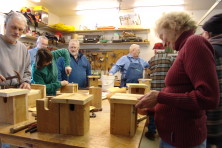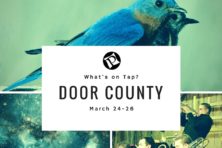A Bluebird Summer
- Share
- Tweet
- Pin
- Share

All but one of the Bluebird eggs have hatched. The last one has been pipped and soon will break open.
With three weeks of official summer remaining, a small group of us “bluebirders” look back in retrospect to 2012 – what we think will be Door County’s best year in a very long time for total number of Eastern Bluebirds fledged. The record so far occurred in 2010 when 100 monitors from our county cared for and made weekly inspections of 627 nest boxes, which produced 1,415 fledged baby Bluebirds.
Tree Swallows are also a part of the nest box scene. With our narrow county being virtually surrounded by two large bodies of water, Green Bay and Lake Michigan, the swallows have excellent hunting for insects over the water. Bear in mind too that it’s common for these tiny but strong fliers to hunt for insects as far as four miles away from their nest box sites. In 2010 Door County nest boxes fledged 691 Tree Swallows. The farther away from these bodies of water you travel, for example to central and western Wisconsin, the fewer Tree Swallows you will encounter.
One of the worst years within the past dozen or more for both Bluebirds and Tree Swallows was 2011. That spring season was very wet and cold which resulted in a disastrous lack of food for the birds. Many perished, especially the young in the nests. Whenever these conditions take place, the adults will always feed themselves first before sharing food with the young. Only 1,062 Bluebirds fledged, along with 533 Tree Swallows in 2011.

A female Bluebird feasts on mealworms.
The nest box monitors discovered many of their nest boxes in the first part of the season having dead baby birds inside, always a deeply disheartening part of being a monitor. These boxes must be emptied, cleaned out entirely, but fortunately adult Bluebirds nearly always will re-nest, hopefully with improvement of weather and more insect food for both adults and young in the nests.
As many of you recall, our spring this year arrived much earlier than normal. Many species of wildflowers established record early blossoming dates. We watched a female Monarch Butterfly lay eggs on some of our front-yard milkweed plants on Mother’s Day, May 13, two weeks earlier than our previous record. The first Bluebirds arrived on March 10, naturally ready to mate and have young.
Then much to our dismay, after a fair number of eggs had already been laid and were being incubated, the weather turned colder. There were quite a few frosty mornings throughout April and into early May that in turn resulted in few insects to be had for the adults. A number of bluebirders helped by ordering live mealworms and feeding them to the adults, who in turn also fed plenty of them to the babies. We bought a total of 4,000 mealworms and placed them, a few dozen at a time, in small plastic cups fastened to the tops of some of the boxes that held babies hungering for food.
Bluebirders from throughout the state reported from early on that the Bluebirds appeared to be wasting little time in nesting, and with excellent results. For all we know, some of the people may even have been singing their theme song, “Bluebird of Happiness!” (Those of you music aficionados may remember that this great song became Jan Peerce’s signature song.) Thus far this summer, with only 19 monitors having reported their summer totals to date, 207 nest boxes have produced 890 fledgling Bluebirds and 275 Tree Swallows. With many monitors who have yet to make their final report, we stand an excellent chance of surpassing our 2010 record of 1,415 Bluebirds fledged.

How beautiful Bluebird eggs are!
Thus far I have not mentioned the number of House Wrens fledged. Regardless of bluebirders wanting Bluebirds to take over their nest boxes, some brushy habitat is sure to have House Wrens, and they, too, need cavities for raising their young. They are a migratory species, consume large quantities of harmful insects and larvae, and they, their eggs and young are fully protected by the law. Through the years we simply have made a practice of not placing our nest boxes even close to what we consider to be good House Wren habitat, generally brushy thickets. I will go into the topic of “House Wrens vs. Eastern Bluebirds” in a future story.
Our champion nest box this summer was on the property of Alice Merkle where absolutely stellar conditions for the Bluebirds exist. Plenty of mown lawn areas along with a lot of excellent perches including overhead power lines, telephone wires, fence wires, a TV antennae, porch railings etc. from which the Bluebirds could perch, scan the ground and hunt for insects.

The male Bluebird, showing more blue in his plumage, takes his turn at the mealworms.
The first brood there produced six fledged Bluebirds while the second produced five fledglings for a grand total of 11 successful fledglings all by the same pair of birds. Generally it’s unusual for there to be three broods in a box at our latitude. It does occur much more frequently farther to the south.
The Bluebird Restoration Association of Wisconsin (BRAW) is holding their annual statewide meeting this year on Sept. 15 at the Birch Creek Music Center located along County Highway E three miles east of Egg Harbor. Many of our county bluebirders are members of this extraordinary organization and profit immensely from their great leadership, suggestions and help. This one-day meeting is open to the general public. Admission to the conference is $5 per person, with an optional box lunch to be served at noon costing an additional $5. You must register for both.
Please contact Charlotte Lukes at 920.823.2478 or by email at [email protected] by no later than Sept. 13. All payments, meeting only or meeting plus a box lunch, will be made at the door. Registration will be from 8 – 9 am in the Concert Barn at Birch Creek. The meeting will begin at 9 am, lunch will be served at noon, and a very helpful panel discussion by expert bluebirders will begin a 1 pm. They will field questions from the audience that in turn will help the many bluebirders attending to improve their construction or care of boxes, handling of young, and keeping good records.
We urge you to attend this very fascinating gathering, meet some of the most interesting and dedicated people you’ve ever had the pleasure of meeting, and it is virtually guaranteed that you will meet the “Bluebird of Happiness!”


